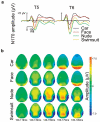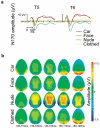The naked truth: the face and body sensitive N170 response is enhanced for nude bodies
- PMID: 22110574
- PMCID: PMC3217929
- DOI: 10.1371/journal.pone.0024408
The naked truth: the face and body sensitive N170 response is enhanced for nude bodies
Abstract
Recent event-related potential studies have shown that the occipitotemporal N170 component--best known for its sensitivity to faces--is also sensitive to perception of human bodies. Considering that in the timescale of evolution clothing is a relatively new invention that hides the bodily features relevant for sexual selection and arousal, we investigated whether the early N170 brain response would be enhanced to nude over clothed bodies. In two experiments, we measured N170 responses to nude bodies, bodies wearing swimsuits, clothed bodies, faces, and control stimuli (cars). We found that the N170 amplitude was larger to opposite and same-sex nude vs. clothed bodies. Moreover, the N170 amplitude increased linearly as the amount of clothing decreased from full clothing via swimsuits to nude bodies. Strikingly, the N170 response to nude bodies was even greater than that to faces, and the N170 amplitude to bodies was independent of whether the face of the bodies was visible or not. All human stimuli evoked greater N170 responses than did the control stimulus. Autonomic measurements and self-evaluations showed that nude bodies were affectively more arousing compared to the other stimulus categories. We conclude that the early visual processing of human bodies is sensitive to the visibility of the sex-related features of human bodies and that the visual processing of other people's nude bodies is enhanced in the brain. This enhancement is likely to reflect affective arousal elicited by nude bodies. Such facilitated visual processing of other people's nude bodies is possibly beneficial in identifying potential mating partners and competitors, and for triggering sexual behavior.
Conflict of interest statement
Figures







Similar articles
-
Additive effects of affective arousal and top-down attention on the event-related brain responses to human bodies.Biol Psychol. 2014 Dec;103:167-75. doi: 10.1016/j.biopsycho.2014.09.003. Epub 2014 Sep 16. Biol Psychol. 2014. PMID: 25224182
-
Category-sensitivity in the N170 range: a question of topography and inversion, not one of amplitude.Neuropsychologia. 2011 Jun;49(7):2082-9. doi: 10.1016/j.neuropsychologia.2011.03.039. Epub 2011 Apr 6. Neuropsychologia. 2011. PMID: 21477606
-
Facilitated early cortical processing of nude human bodies.Biol Psychol. 2015 Jul;109:103-10. doi: 10.1016/j.biopsycho.2015.04.010. Epub 2015 May 7. Biol Psychol. 2015. PMID: 25960070
-
Does physical interstimulus variance account for early electrophysiological face sensitive responses in the human brain? Ten lessons on the N170.Neuroimage. 2008 Feb 15;39(4):1959-79. doi: 10.1016/j.neuroimage.2007.10.011. Epub 2007 Oct 22. Neuroimage. 2008. PMID: 18055223 Review.
-
A scoping review and index of body stimuli in psychological science.Behav Res Methods. 2024 Sep;56(6):5434-5455. doi: 10.3758/s13428-023-02278-z. Epub 2023 Nov 29. Behav Res Methods. 2024. PMID: 38030921
Cited by
-
Occipital event-related potentials to addiction-related stimuli in detoxified patients with alcohol dependence, and their association with three-month relapse.BMC Psychiatry. 2016 Mar 21;16:74. doi: 10.1186/s12888-016-0782-0. BMC Psychiatry. 2016. PMID: 27000120 Free PMC article.
-
Recognition Characteristics of Facial and Bodily Expressions: Evidence From ERPs.Front Psychol. 2021 Jul 5;12:680959. doi: 10.3389/fpsyg.2021.680959. eCollection 2021. Front Psychol. 2021. PMID: 34290653 Free PMC article.
-
Neuroaffective Processing of Sexually Relevant Images in Hetero- and Homosexual Women and Men: Subjective, Pupillometric, and Magnetoencephalographic Correlates.Psychophysiology. 2025 Jul;62(7):e70096. doi: 10.1111/psyp.70096. Psychophysiology. 2025. PMID: 40702879 Free PMC article.
-
Reduced processing of facial and postural cues in social anxiety: insights from electrophysiology.PLoS One. 2013 Sep 9;8(9):e75234. doi: 10.1371/journal.pone.0075234. eCollection 2013. PLoS One. 2013. PMID: 24040403 Free PMC article.
-
Basic instinct undressed: early spatiotemporal processing for primary sexual characteristics.PLoS One. 2013 Jul 19;8(7):e69726. doi: 10.1371/journal.pone.0069726. Print 2013. PLoS One. 2013. PMID: 23894532 Free PMC article.
References
-
- Hari R, Kujala MV. Brain basis of human social interaction: from concepts to brain imaging. Physiol Rev. 2009;89:453–479. - PubMed
-
- Allison T, Puce A, McCarthy G. Social perception from visual cues: role of the STS region. Trends Cogn Sci. 2000;4:267–278. - PubMed
-
- Haxby JV, Hoffman EA, Gobbini MI. The distributed human neural system for face perception. Trends Cogn Sci. 2000;4:223–233. - PubMed
-
- Perrett DI, Hietanen JK, Oram MW, Benson PJ. Organization and functions of cells responsive to faces in the temporal cortex. Philos Trans R Soc Lond B Biol Sci B. 1992;335:23–30. - PubMed
-
- Fairhall SL, Ishai A. Effective connectivity within the distributed cortical network for face perception. Cereb Cortex. 2007;17:2400–2406. - PubMed
Publication types
MeSH terms
LinkOut - more resources
Full Text Sources

